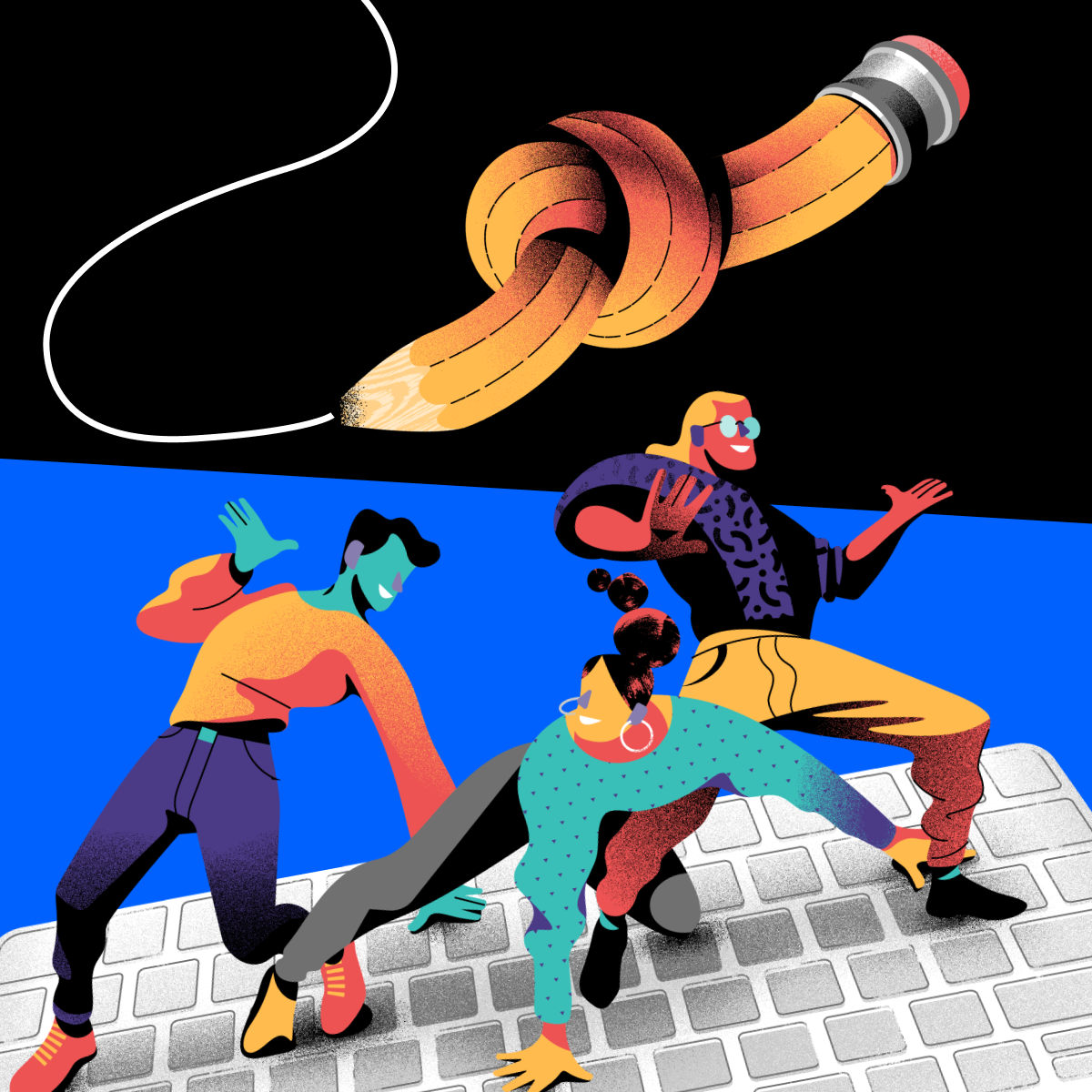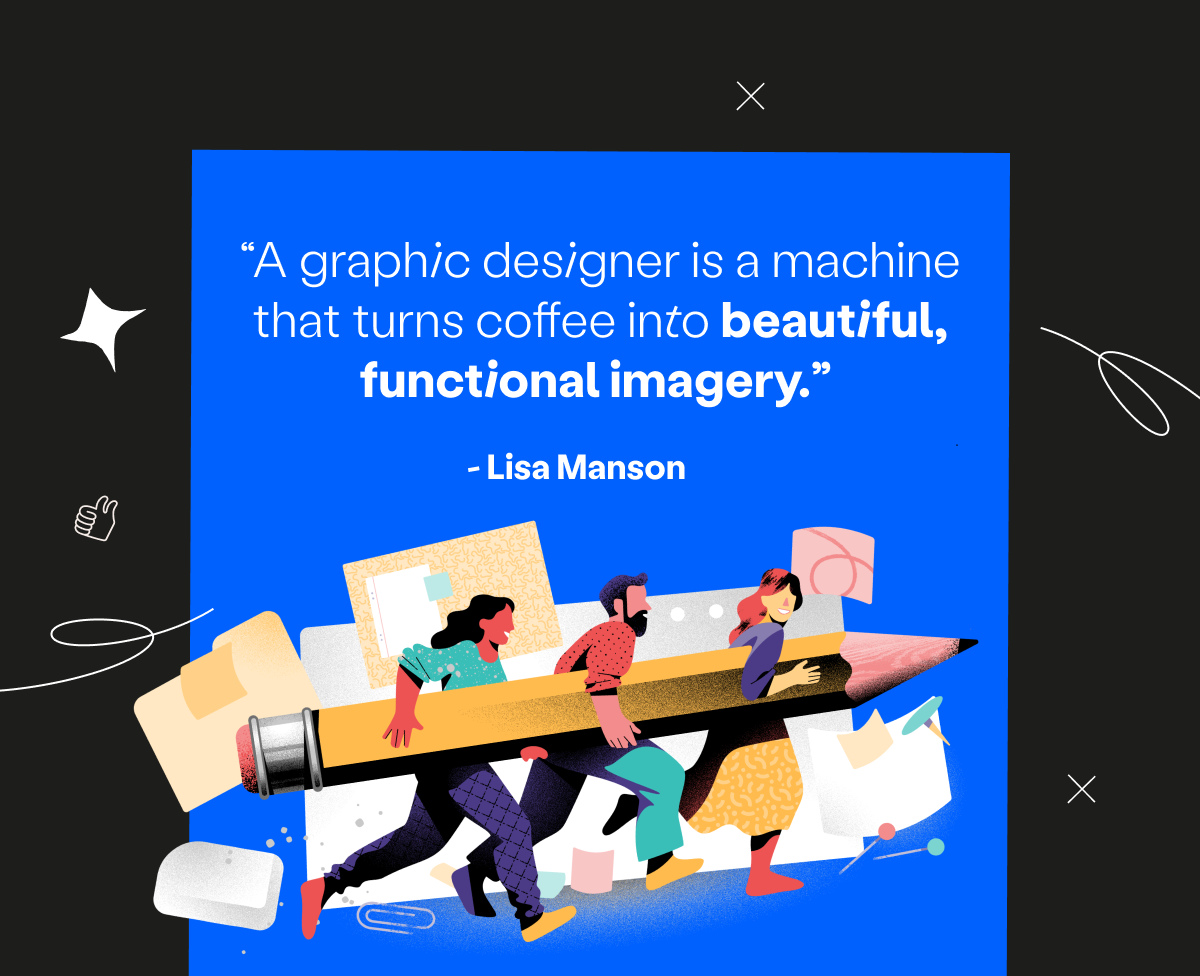
So, you want to be a graphic designer. Or is that an art director?🤔
While at first glance, one might seem like a natural progression from the other, the truth is that art directors and graphic designers have distinct roles in the realm of visual communication and creative design. While both contribute to the creation of stunning visuals, they have different primary focuses and responsibilities.
While it’s totally possible to progress from graphic designer to art director if that’s what you aspire to, it’s essential to get familiar with the differences between them and what’s required of each role. This will help you decide whether an art director career is right for you and allow you to focus on developing the skills you need to become one.
To help you get started, this article will cover the main differences between graphic designers and art directors, the collaborative dynamics between them, and career path perspectives for both.
Understanding the role of an art director in the creative industry
Art directors are the visionary leaders behind creative projects and are responsible for shaping the overarching concept and creative direction. Their primary focus revolves around translating ideas and concepts into compelling visuals. Unlike graphic designers, who primarily execute the designs, art directors set the stage, giving the project its unique flavor and artistic direction.
Art directors often have a high level of decision-making authority within a project. They make critical decisions about the creative direction, design elements, and the overall look and feel of the project, as well as managing budgets and timelines, leading brainstorming sessions, and handling project management. Their ability to shape the project’s creative vision makes them integral to the decision-making process.
Art directors wear many hats and have a wide range of responsibilities. They oversee the creative aspects of a project, working closely with a team of creative professionals, including graphic designers, illustrators, photographers, and copywriters. Their duties often include:
- Conceptualization: defining the visual and artistic aspects of a project, such as aligning the visual narrative with the project’s objectives.
- Design direction: guiding the design process, providing direction to graphic designers and other team members, and ensuring the work produced is in line with the project’s creative vision.
- Team Management: managing and leading the creative team to ensure everyone is on the same page and working harmoniously toward a common goal.
- Client communication: bridging the gap between the creative team and clients and helping to translate client needs and expectations into the creative direction of the project.
- Quality control: overseeing quality standards throughout the project to ensure the final output meets or exceeds client expectations.
Art directors usually have an educational background in a relevant field, such as graphic design, fine arts, or visual communications. A bachelor’s degree is often a prerequisite, but some art directors may hold advanced degrees, and experience is a crucial component of their qualifications. They typically have several years of experience working in related positions, gaining expertise in design and creative direction. The skills required to excel as an art director include:
- Creative vision
- Technical design skills
- Leadership skills
- Strategic thinking
- Problem-solving skills
- Communication skills
- Attention to detail
In terms of salary, art directors typically earn more than graphic designers due to their elevated responsibilities and leadership role. The average salary varies depending on factors such as location, experience, and the industry they work in. However, as of 2023, the average annual salary for art directors in the United States ranges from $50,000 to $112,000.
The role of a graphic designer: crafting the visual essence

Graphic designers are the skilled artisans who bring the visual components of a project to life. Their primary focus is on the aesthetics and visual appeal of a design, translating concepts into captivating visuals by following the guidance of the art director. Graphic design roles vary greatly and can range from designing anything from social media creatives to video games.
Graphic designers play a pivotal role in creating visually appealing and effective designs. Their duties encompass conceptualization, ideation, visual design work, handling technical design aspects, and collaborating with clients to bring their vision to life.
While graphic designers contribute significantly to the visual aspects of a project, they typically have a lower level of decision-making authority compared to art directors.
To be successful as a graphic designer, you’ll need a blend of creativity, technical proficiency in design software, knowledge of design principles, effective communication, an eye for detail, problem-solving acumen, and adaptability to meet the demands of different projects.
Most graphic design roles require a qualification in graphic design, visual communication, or a related field is commonly required, and additional skills, such as typography or UX design, are a plus.
Gaining experience as a graphic designer often begins with internships or apprenticeships at a design agency or studio, and a strong portfolio is crucial to showcase your skills and creativity.
The salary range for graphic designers can vary widely based on factors including location and experience. As of 2023, the average annual salary for graphic designers in the United States ranges from $37,000 to $70,000.

Collaborative dynamics between art directors and graphic designers
In the world of creative projects, art directors and graphic designers have complementary roles, collaborating closely within a creative team for impactful and coherent creative outcomes. Effective communication and synergy between these roles are paramount for achieving project goals and maintaining a seamless creative process.
Successful design projects hinge on teamwork: art directors guide the overarching creative vision, while graphic designers execute the visual elements, ensuring that projects meet their objectives and maintain a cohesive aesthetic.
For example, when working on a brand identity project, the art director works with the client to define the brand’s visual identity, while the graphic designers bring that vision to life with logos, color schemes, and visual elements that align with the brand’s values.
Or, in an ad campaign, the art director conceptualizes the campaign’s look and feel together with the client, and the graphic designers execute it. Together, they create visually striking ads that effectively convey the campaign’s message.

Why understanding the difference matters
Understanding the different roles art directors and graphic designers play can both help you choose the right career path and work effectively within creative teams.
Having clearly defined roles and responsibilities minimizes confusion, helping teams work cohesively and leading to smoother workflows, reduced conflicts, and higher-quality results.
When art directors focus on the creative direction, graphic designers can concentrate on the finer details, resulting in projects that align with the vision and meet or exceed client expectations. Clarity in roles enhances efficiency, fosters collaboration, and ensures project success.
Career perspectives for art directors
Many art directors start as graphic designers or in related roles, progressing to senior graphic designers as they gain experience before advancing to senior art director positions. With time, they can aspire to roles as creative directors or even chief creative officers, involving more strategic leadership in creative projects.
Art directors can diversify into specialized fields such as film and video production (as film directors or production designers), advertising (creative directors), or web design (web design directors).
By expanding their skills, collaborating with larger teams, and handling high-profile projects, art directors can carve out impressive careers. They may explore opportunities in larger agencies, establish their creative firms, or transition into academia as educators and mentors, ensuring a rich and varied career path in the creative industry.
Career perspectives for graphic designers
Graphic designers often kickstart their careers as junior designers, progressively advancing to roles like senior designer, design manager, or creative director, where they manage design teams and projects.
They have a wealth of potential roles in specialized areas, including web design, UX/UI design, print design, packaging design, and branding. Opportunities also extend to related fields like illustration, multimedia design, and user experience design.
Growth lies in continuously refining design skills, mastering design software, staying attuned to design trends, and potentially transitioning into freelance work or entrepreneurship, allowing them to work with diverse clients and industries.
Career advice for aspiring art directors
If you think a career in art direction is the path for you, here are some valuable steps to help you land your first art director job:
Gain experience by starting your journey as a graphic designer or in a junior creative role. This practical experience offers insights into design processes and fosters a deep understanding of the field.
Since art directors lead teams of graphic designers, you should focus on honing your leadership and communication skills. Art direction demands the ability to guide and coordinate creative teams effectively, ensuring everyone works cohesively.
While acquiring strong design skills is essential, building a strong professional network within the industry is just as important for growing and finding new opportunities. Seek mentorship from experienced art directors who can provide invaluable guidance, share insights, and help you navigate your career path.
Finally, it’s important to diversify your skills by exploring various design disciplines, such as digital design, photography, and video production. Diversifying your skill set enhances your versatility and can open doors to a broader spectrum of creative opportunities.
Career advice for aspiring graphic designers
Graphic design can be an exciting and fulfilling career, even if you don’t aspire to an art director role. Here are some tips for growing your career as a graphic designer:
Start by creating a diverse and captivating portfolio of your work, showcasing your design abilities and creativity to potential clients and employers. Your portfolio should highlight your best work and exhibit your skills in design thinking and problem-solving.
In terms of technical skills, you’ll need to master industry-standard design software like Adobe Creative Suite, including Photoshop, Illustrator, and InDesign, as well as keeping pace with design trends, new technologies, and emerging software.
A few ways to do this include investing in your design knowledge by attending workshops, online courses, and conferences. Staying current ensures your work remains competitive and relevant in an ever-evolving field and can also help you expand your network and advance your design career.
Finally, look for freelancing opportunities that give you exposure to a wide range of projects and clients to gain hands-on experience, refine your skills, and build a diverse portfolio.
Design your creative future
In the dynamic world of design, recognizing the distinctions between graphic designers and art directors is essential for defining clear roles and achieving effective collaboration that leads to exceptional outcomes. It can also help you steer your career in the direction that makes most sense for you.
If you’re a graphic designer aspiring to transition into art director roles, check out this piece: “From graphic design to creative direction: A career guide” that maps out the steps to take to elevate your career to a creative director role.
